How to replace a jigsaw file?

The jigsaw is a tool familiar to many men from childhood, from school labor lessons. Its electric version is currently one of the most popular hand tools, which greatly facilitated the work of home craftsmen. Unlike a hand saw, this electrical appliance needs more attention, especially its most important element - the movable unit with a removable file.
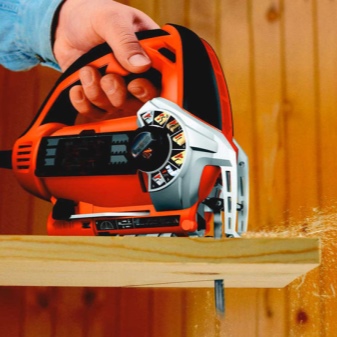

What can be a file holder?
The saw is connected to the movable rod of the jigsaw by means of a saw holder - one of the most vulnerable parts of the unit. It is the blade holder that experiences the greatest stress during the operation of the device, this device especially suffers when using a blade with blunt teeth, which is sometimes allowed by inexperienced craftsmen.
The material for this part is supposed to be of the highest quality, but not all manufacturers think the same way. It is often the saw holder that needs to be repaired or replaced first. Today's power tool manufacturers are constantly working to improve this unit.
This has led to a wide variety of saw holders used for jigsaws.



The earliest design is a bolt-on clamp. Although many companies have long since abandoned this option, models where this archaic mount is used are still found. There are two bolts on such a block. One clamps the canvas, and the second allows you to adjust its position.
When installing or removing the saw blade, both screws must be unscrewed or tightened. Their heads are made for a flat screwdriver or for a hex wrench. For such pads, the shape and thickness of the saw shank often does not matter. There are also models with one bolt. It is not necessary to adjust such a lock, the file is simply clamped by tightening the bolt.
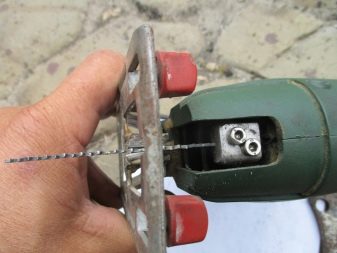

The quick-release fastener is installed on most modern models of jigsaws. Pressing a special key releases the clamp, and the blade easily comes out of the mount. The same manipulation will make it easy to insert the file into the slot. Such a device does not need to be adjusted and has no bolts. This type of fastening is divided into two subtypes, according to the position of the movable key mechanism: side and front.
The radial clamp is a type of quick-release fastening. It is even easier to insert a file into units equipped with such a unit. The device must be rotated 90 degrees, insert the file into the slot and release, under the action of the spring the clamp will return to its initial position and automatically fix the blade shank. All quick-release fasteners have a strict limitation on the thickness of the blade and the shape of its shank.


Some craftsmen prefer to make this knot with their own hands, thus trying to increase its working time. Indeed, it is not always possible to buy a part of the same quality. You can make a file holder-block from a steel bar with an edge length of no more than 2 cm. The following tools are needed for work: a drill, a hacksaw for metal, a grinder, a vice, an accurate tape measure, and a caliper.
Using an old part, you need to try to copy it, making a homemade one from a bar. If there is no skill in such work, it is better not to waste time, but show the old file holder and the workpiece to an experienced craftsman. If you still decide to do it yourself, be patient and, just in case, prepare a couple more blanks.
When replacing a file in a jigsaw, pay attention to the condition of the attachment point - the most vulnerable part of the entire tool. Over time, there may be backlash, blade runout, displacement of the cut from the marking.
All these signs indicate an impending problem with fastening and it is better to find out their cause at an early stage.


How to insert a file into a jigsaw?
An electric jigsaw is not that old, it is about 30 years old. Having changed little constructively, it has gone quite far from the prototype in terms of usability and power. The fastening that holds the canvas has undergone the greatest upgrades. Shoe markings - the knot is quite simple and it is usually not difficult to insert a file into it, especially since the shape of its shank and the thickness for such an attachment are absolutely irrelevant.
- To put the file in the block, you need to slightly loosen both mounting bolts counterclockwise. The blade is inserted with the teeth forward, then the bolts are tightened alternately, evenly. It is necessary to ensure that there is no skewing of the canvas. You need to tighten enough.
- If there is one screw on the file holder, then it will also be easy to change the files, you only need to tighten one bolt. In order to properly install the canvas, you need to check its position from time to time, slightly adjusting it with your hand. It is not recommended to tighten to failure, this creates excessive vibration and can affect the quality of the cut.
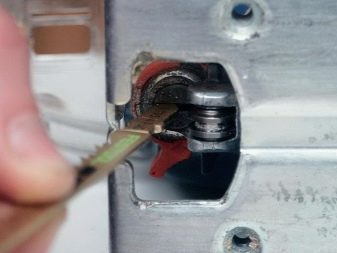

- In quick-clamping devices, it is even easier to replace the file: by pressing and holding the key, insert the shank of the corresponding file, release the key. If a click is heard, the shank is secured with a saw holder.
- The radial mount is just as easy to handle. If the jigsaw has such a fixation option, then when installing the saw blade it is very important not to confuse the shape of the shank. Currently, the industry produces saws with two types of shanks: T-shaped and U-shaped. The first file type is currently the most common. The U-shaped shank has an additional hole for securing the blade.


Jigsaw blades are divided into several basic types, which can be identified by the shape and size of the teeth, as well as by marking. Various files allow you to successfully cope with cutting wood (boards), plywood, chipboard, plastic, metal, tiles, drywall, glass.
- Wooden workpieces are sawn using a long saw with teeth from 3 to 5 mm, with a noticeable gap. These files are marked HCS, as well as an additional - T101D, indicating a large size of the teeth.
- Metal can be cut with a shorter file with 1-1.5 mm teeth and a wavy set, the HSS marking and the T118A index will also help in choosing a file.
- For the laminate, webs with a reverse slope have been developed.
In the marking of such a file there will be an index T101BR, the last letter indicates the reverse position of the teeth.
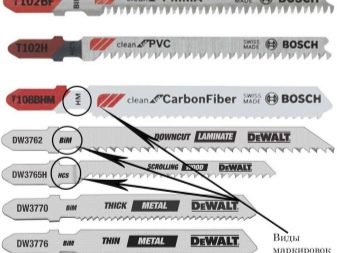

- Plastic is sawn with blades with an average size of teeth (up to 3 mm), with a small set.
- Special blades for ceramics have no teeth at all, they are coated with carbide spraying.
- There are universal files that cut basic materials, but, of course, such products are not suitable for every job.
- Models for curved cut have a small width and the T119BO index.
When using the saw blade, one must not forget that this is a consumable material and it makes no sense to waste time sharpening dull teeth. A file that has become unusable must be replaced.

How to insert into a hand jigsaw?
A manual jigsaw is a tool that has long been mastered by carpenters, its design has been perfected over the years of operation and has become as simple as possible. Problems with its use and, accordingly, replacing files are much less than with an electric namesake. The saw blade for this tool, as well as for the jigsaw, is a consumable item. It is not repaired or sharpened.
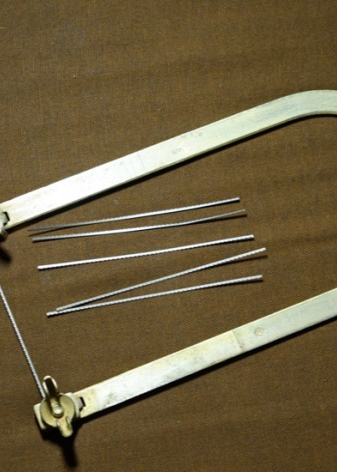

The most problematic place is, of course, the file attachment. It must be installed without skewing. When fixing the blade, a tight adhesion to the clamping bar must be ensured. The teeth of the saw blade should point towards the handle of the tool during installation. Replacing or installing the blade in a hand jigsaw is required quite often.
- In order to install the saw into the jigsaw holders, it is necessary to secure the edge of the saw to one of the ends of the handle. Then, slightly squeezing the edges of the handle (sometimes you have to lean on them with your body weight), insert the second edge of the file.
- The file is inserted with one hand, the other must be screwed in at the same time. For a stronger connection, if there is not enough muscle strength, pliers have to be used, in this case the main thing is not to rip the thread.
- You need to change the file in the reverse order. If the blade breaks, of course, you do not need to clamp the edges of the handle. Having loosened the wing fasteners, it is necessary to pull out the fragments of the canvas one by one.


Sometimes, after a long period of use, you have to replace the mount. It is not difficult to remove this knot from the jigsaw - the same lamb turns away.
There are hand jigsaws not with a flat, but with a tubular handle. Getting a file out of such a tool is not much more difficult. For such jigsaws, a simple device has been invented. Two holes are drilled in the surface of the workbench or sawing table.
The edges of the handle are inserted into them, and the file is tightened with the clamping bars.
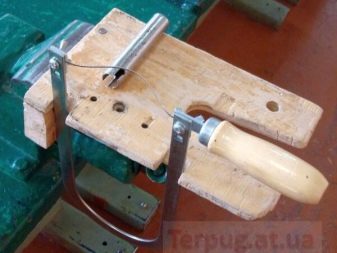
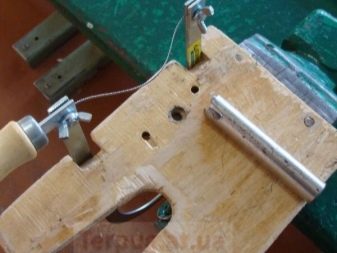
Installation in a jigsaw
Stationary jigsaws (jigsaws) are the result of the natural evolution of electric hand tools. When working with such a unit, both hands of the master can manipulate the material, which significantly increases productivity and makes it easier to work with oversized workpieces.
For such electrical appliances, special canvases are used, although craftsmen sometimes adapt the canvases of a hand jigsaw. Pin files have a special pin at the end, which makes fastening more secure. Pinless, respectively, do not have a special device and remain flat. Blades can be with or without a set of teeth.


Installing the file into the machine is actually quite simple.
- The saw blade is fixed in special grooves, first in the lower one, and then in the upper one. The blade teeth are directed downward and towards the sawer. You need to tighten the canvas with a lever, the stretched file should ring from the impact.
- Pinless files need to be tightened especially carefully, they have a tendency to jump out of the clamping device, however, they remain popular, due to the wide range of applications for cutting complex-shaped products.
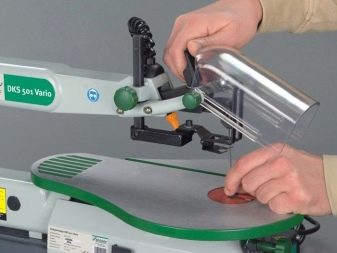

Possible problems
An electric jigsaw is a fairly reliable electrical device, all of its components during normal operation can work for quite a long time without any interruptions or interference. But the file holder, even with the most careful handling, is doomed to breakage and ultimately be replaced, not to mention the files, replacement of which is a natural and necessary measure.
- One of the problems remains to determine the degree of tightening of the fasteners of the canvases. It cannot be overtightened - this can cause the blade to break, but it cannot be under-tightened either, in which case the blade dangles, and it is impossible to make an accurate cut with it, it may even fly out of the saw holder during operation.
- Over time, with intensive work, the saw bolts have to be replaced, the edges are erased and it becomes difficult to wrap them, less often the thread of the bolt or in the block itself is broken, in the latter case the device will have to be replaced.
- Failure to pay attention to the condition of the saw can cause overheating of the engine or damage to the jigsaw stem. It is better to throw away blades with blunt teeth immediately, and not put them off "for a rainy day", high-quality work of the tool with them is impossible.

- If the file turns out to be bent, it is also not worth hoping for high-quality work, the cut will be taken to the side.
Trying to straighten the file is useless, it is better to replace it with a new one.
- Working with a blunt or bent file can cause charring of the wood, and this is also one of the signs of overloading the appliance.
- A guide roller is installed in jigsaws, if it is not lubricated in time, this can lead to jamming of the unit and, as a result, overload of the jigsaw motor. In severe cases, the roller has to be replaced.

- monitor the position of the electrical cord;
- monitor the cleanliness of the air intake openings supplying air for cooling the electric motor;
- periodically cool the unit, for example, by driving it idle for some time;
- do not cut with excessive force, this can cause the saw to be clamped, the rod or the clamping device malfunctioning.
For information on how to insert a file into a jigsaw, see the next video.













The comment was sent successfully.